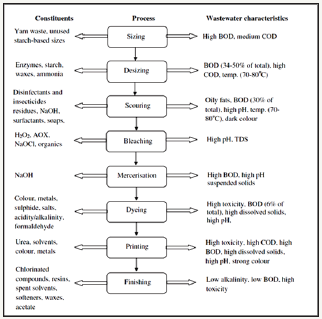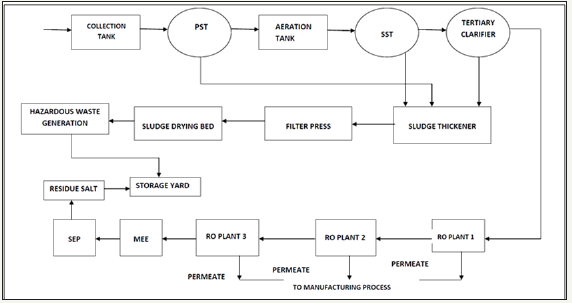- Submissions

Full Text
Trends in Textile Engineering & Fashion Technology
Effluent Management in Textile Industry
Ninad Oke*
Department of Civil Engineering, Indian Institute of Technology Madras, India
*Corresponding author: Ninad Oke, Research Scholar, Department of Civil Engineering, Indian Institute of Technology, Madras, India
Submission: April 01, 2018;Published: May 11, 2018

ISSN 2578-0271Volume2 Issue3
Abstract
This article presents a study on effective effluent management and resource recovery options for the textile industry. Textile manufacturing activities for Indian textile sector are widely distributed among various small-scale operation units. The study attempts at utilizing the large potential for resource recovery through effective effluent management at such facilities. It has been reported that nearly 40% of total applied dye finds way in the textile effluents in the form of complex hydrolysed dye molecules. Presence of various auxiliary chemicals further limit direct reuse of the dyeing effluent streams. Present study analyses required extent of treatment optionsaimed at recycling and reuse of the textile effluents. This study under lines importance of management options for inorganic salt residues from Zero Liquid Discharge (ZLD) treatment facilities. The study attempts towards the sustainable waste management strategy for textile industry addressing both solid and liquid waste streams.
Introduction
For any major industrial production process, sustainability has become a major concern currently. To achieve the sustainable development, appropriate management of solid and liquid waste streams can be considered as the key issue to be addressed.
The textile industry uses vegetable fibers like cotton, animal fibers like wool, silk and various synthetic polymers like nylon, polyester and acrylics. Polyester has a maximum contribution of about 50% among various synthetic fibers [1]. Majority of the garments exported from India are cotton based. The stages of textile production can be briefly listed as fiber production, fiber processing and spinning, yarn preparation, fabric production, bleaching, dyeing and printing, and finishing. Textile industries are one of the largest consumers of water, dyes and various processing chemicals that are used during the various stages of textile processing. The effluents generated from textile mills are found to have higher pollution load, higher volumetric load and consisting of spent or unutilized resources [2].
Figure 1: Flowchart of textile fabrication.
(Source: Manikandan et al. [4])

It is important to recycle the process water in textile industry and reduce the overall water consumption. The recycling of process water can further reduce wastewater generation leading to minimum impact of textile industry on the natural water bodies. Textile industries consume large volume of water and chemicals for wet processing of textiles. The water consumption in textile manufacturing is reported to be 200 L per kg for Indian scenario [3]. The wastewater obtained from the textile industry is usually rich in colour, chemical oxygen demand (COD), complex chromophores, inorganic salts, total dissolved solids (TDS) and heavy metals which underlines the importance of effluent treatment in textile industry. The amount of waste sludge generated from effluent treatment processes along with the associated toxicity is a major concern. In India, textile industry contributes to the major water consumption by industrial sector. As per the CPCB report of 2007, there are 2324 textile industries in the country including composite and process houses. It can be seen from these data that there are 83 composite mills in the country. Rest 2241 are semi composite and processing units which underlines the need of study of individual effluent streams from different manufacturing stages. The resource recovery approach should be practiced for the textile effluent treatment in India, making it applicable for small scale industries in terms of economic returns. The flow chart showing various stages of textile manufacturing along with general characteristics of wastewater generated from different stages is shown below (Figure 1).
The discharge limits set by standards on Chromium, sulphide and phenolic compounds indicate a concern about toxicity of the discharged wastewater to aquatic life. The discharge standards are applicable to textile units having wastewater discharge less than 25 KLD [5-7]. As per the recent amendments in the rules, all units having wastewater discharge more than 25 KLD must establish a zero liquid discharge effluent treatment plant. As per the recent amendments, all the common effluent treatment plants for textile industry cluster units should be upgraded to zero liquid dischargecommon effluent treatment plants. It is clearly stated in the rules that member units should use recycled water supplied by the ZLDCETP as a process water and limit ground water abstraction only for makeup water and drinking purpose. This underlines the need of improvement in efficiency of existing common effluent treatment plants to achieve zero liquid discharge status.
Zero liquid discharge units
In the zero liquid discharge units no liquid effluent is to be discharged out of the facility boundaries. The water recovered after treatment is either reused as process water or recycled as the boiler feed water. The effluents from various stages are first collected in collection tank [8]. The first step of the treatment is Primary Settling Tank (PST) followed by the secondary biological treatment. The sludge from primary and secondary settling tank is feed to filter press to reduce the volume and then stored in storage yard at the facility. After secondary treatment, the treated water is feed to Reverse Osmosis (RO) treatment unit. The permeate from RO unit is reused as process water and the reject from RO unit is feed to Multiple Effect Evaporator (MEE). The water recovered from MEE is used as the boiler feed water. The residue from MEE is sent to Solar Evaporation Platform (SEP) and the residual salts need to be stored at the facility in storage yard. Following figure shows a general flow sheet of zero liquid discharge facility [9]; (Figure 2).
Figure 2: Flowchart of zero liquid discharge treatment facility.

From the observations at site and hazardous waste quantity estimations, it was found that daily sludge generation from clarifiers varies between 103.2kg to 145.2kg. The daily residual salt generation was found to vary from 95kg to 147kg. Such a huge amount of resources need not to simply end up at the hazardous waste landfill site, and novel recycle options need to be considered for these residues.
Conclusion
From the present work it can be concluded that the solid and liquid waste streams from the textile manufacturing units have a significant resource recovery potential. The high pollution load appearing in the wastewater needs to be properly managed before causing significant environmental hazards. The major advantage of the concept of zero liquid discharge facilities lies in a potential water recycle, which ensures process water supply of nearly constant characteristics. This further limit the excessive ground water extraction by the textile industry.
One of the major concerns for zero liquid discharge facilities is management of hazardous solid waste generated from the treatment facility. Attempts should be made to improve the primary and secondary treatment stages to reduce the sludge production from clarifiers.
The load on treatment systems can be significantly reduced by process modifications, aimed at reducing water and chemical consumption. Along with the research on possible reductions in the salt requirements for dye fixation one can also investigate options for direct reuse of residual salts. Considering a constantly growing global competition in the textile sector, sustainable production only can help to maintain competitive product costs along with reduced impact on the environment.
References
- Jena B, Das BP, Khandual A, Sahu S, Behera L (2015) Ecofriendly processing of textiles. Materials Today: Proceedings 2(4-5): 1776-1791.
- Dasgupta J, Sikder J, Chakraborty S, Curcio S, Drioli E (2015) Remediation of textile effluents by membrane based treatment techniques: a state of the art review. J Environ Management 147: 55-72.
- Holkar CR, Jadhav AJ, Pinjari DV, Mahamuni NM, Pandit AB (2016) A critical review on textile wastewater treatments: possible approaches. Journal of Environmental Management 182: 351-366.
- Manikandan P, Palanisamy PN, Baskar R, Sivakumar P, Sakthisharmila P (2015) Physico chemical analysis of textile industrial effluents from Tirupur city, TN, India. International Journal of advance research in Science and Engineering 4(2): 93-104.
- Alkaya E, Demirer GN (2014) Sustainable textile production: a case study from a woven fabric manufacturing mill in Turkey. Journal of Cleaner Production 65: 595-603.
- Babu BR, Parande AK, Raghu S, Kumar TP (2007) Cotton textile processing: waste generation and effluent treatment. Journal of Cotton Science 11: 141-153.
- Bilińska L, Gmurek M, Ledakowicz S (2017) Textile wastewater treatment by AOPs for brine reuse. Process Safety and Environmental Protection 109: 420-428.
- Burkinshaw SM, Salihu G (2017) The role of auxiliaries in the immersion dyeing of textile fibres: Part 1 an overview. Dyes and Pigments.
- Wang Z, Xue M, Huang K, Liu Z (2011) Textile dyeing wastewater treatment. Advances in Treating Textile Effluent pp. 91-116.
© 2018 Ninad Oke. This is an open access article distributed under the terms of the Creative Commons Attribution License , which permits unrestricted use, distribution, and build upon your work non-commercially.
 a Creative Commons Attribution 4.0 International License. Based on a work at www.crimsonpublishers.com.
Best viewed in
a Creative Commons Attribution 4.0 International License. Based on a work at www.crimsonpublishers.com.
Best viewed in 







.jpg)






























 Editorial Board Registrations
Editorial Board Registrations Submit your Article
Submit your Article Refer a Friend
Refer a Friend Advertise With Us
Advertise With Us
.jpg)






.jpg)














.bmp)
.jpg)
.png)
.jpg)










.jpg)






.png)

.png)



.png)






